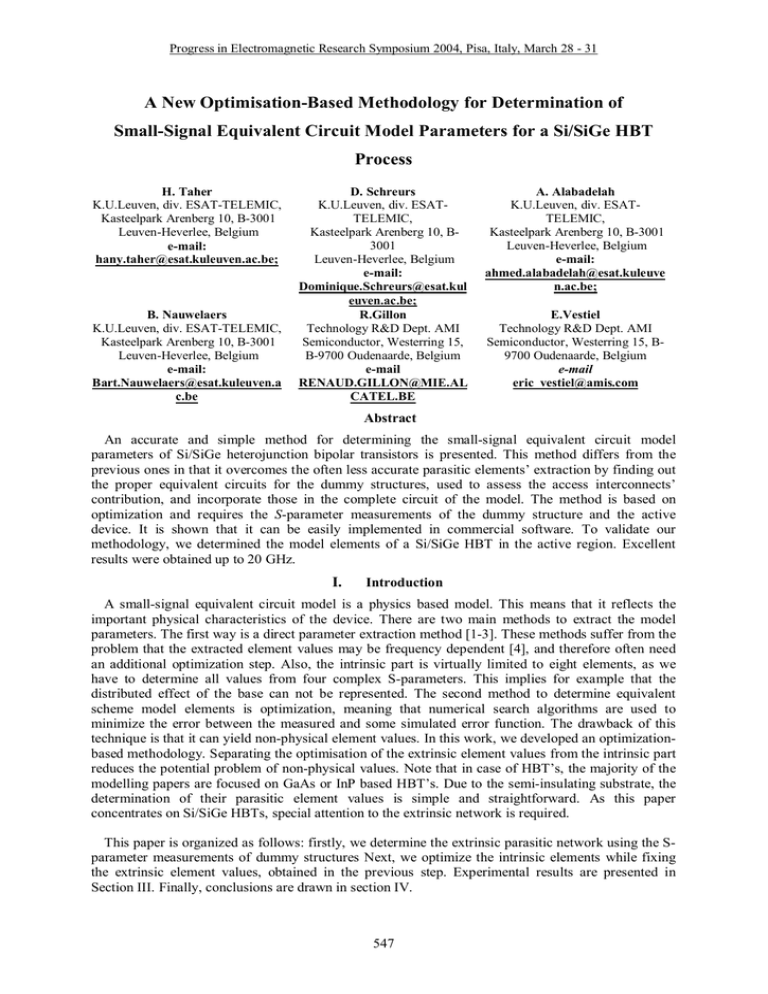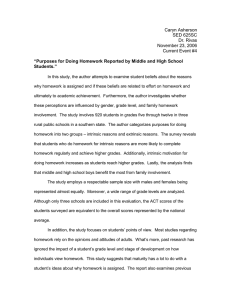A New Optimisation-Based Methodology for Determination of Small
advertisement

Progress in Electromagnetic Research Symposium 2004, Pisa, Italy, March 28 - 31 A New Optimisation-Based Methodology for Determination of Small-Signal Equivalent Circuit Model Parameters for a Si/SiGe HBT Process H. Taher K.U.Leuven, div. ESAT-TELEMIC, Kasteelpark Arenberg 10, B-3001 Leuven-Heverlee, Belgium e-mail: hany.taher@esat.kuleuven.ac.be; B. Nauwelaers K.U.Leuven, div. ESAT-TELEMIC, Kasteelpark Arenberg 10, B-3001 Leuven-Heverlee, Belgium e-mail: Bart.Nauwelaers@esat.kuleuven.a c.be D. Schreurs K.U.Leuven, div. ESATTELEMIC, Kasteelpark Arenberg 10, B3001 Leuven-Heverlee, Belgium e-mail: Dominique.Schreurs@esat.kul euven.ac.be; R.Gillon Technology R&D Dept. AMI Semiconductor, Westerring 15, B-9700 Oudenaarde, Belgium e-mail RENAUD.GILLON@MIE.AL CATEL.BE A. Alabadelah K.U.Leuven, div. ESATTELEMIC, Kasteelpark Arenberg 10, B-3001 Leuven-Heverlee, Belgium e-mail: ahmed.alabadelah@esat.kuleuve n.ac.be; E.Vestiel Technology R&D Dept. AMI Semiconductor, Westerring 15, B9700 Oudenaarde, Belgium e-mail eric_vestiel@amis.com Abstract An accurate and simple method for determining the small-signal equivalent circuit model parameters of Si/SiGe heterojunction bipolar transistors is presented. This method differs from the previous ones in that it overcomes the often less accurate parasitic elements’ extraction by finding out the proper equivalent circuits for the dummy structures, used to assess the access interconnects’ contribution, and incorporate those in the complete circuit of the model. The method is based on optimization and requires the S-parameter measurements of the dummy structure and the active device. It is shown that it can be easily implemented in commercial software. To validate our methodology, we determined the model elements of a Si/SiGe HBT in the active region. Excellent results were obtained up to 20 GHz. I. Introduction A small-signal equivalent circuit model is a physics based model. This means that it reflects the important physical characteristics of the device. There are two main methods to extract the model parameters. The first way is a direct parameter extraction method [1-3]. These methods suffer from the problem that the extracted element values may be frequency dependent [4], and therefore often need an additional optimization step. Also, the intrinsic part is virtually limited to eight elements, as we have to determine all values from four complex S-parameters. This implies for example that the distributed effect of the base can not be represented. The second method to determine equivalent scheme model elements is optimization, meaning that numerical search algorithms are used to minimize the error between the measured and some simulated error function. The drawback of this technique is that it can yield non-physical element values. In this work, we developed an optimizationbased methodology. Separating the optimisation of the extrinsic element values from the intrinsic part reduces the potential problem of non-physical values. Note that in case of HBT’s, the majority of the modelling papers are focused on GaAs or InP based HBT’s. Due to the semi-insulating substrate, the determination of their parasitic element values is simple and straightforward. As this paper concentrates on Si/SiGe HBTs, special attention to the extrinsic network is required. This paper is organized as follows: firstly, we determine the extrinsic parasitic network using the Sparameter measurements of dummy structures Next, we optimize the intrinsic elements while fixing the extrinsic element values, obtained in the previous step. Experimental results are presented in Section III. Finally, conclusions are drawn in section IV. 547 Progress in Electromagnetic Research Symposium 2004, Pisa, Italy, March 28 - 31 II. Modeling procedure II.1 Modeling of the pad and access transmission line parasitics The complete small-signal equivalent circuit for a Si/SiGe HBT as seen from the probe tips is shown in fig. 1. We distinguish two parts: the intrinsic core of the device and the external parasitics. In this subsection we concentrate on the parasitics, while the extraction of the intrinsic elements is discussed in the next Subsection. Concerning the parasitics, we can deduce three types from fig. 1: pad parasitics, impedance or series parasitics of the access transmission lines, and admittance or parallel parasitics of the access transmission lines. In case of the direct extraction technique, the first step would be to subtract the effect of these parasitics. Their values can be obtained from measuring dummy structures, as shown in fig. 2, and then applying any one from the methods described in Refs. [1-3]. This approach however has two disadvantages: firstly, the subtracting process increases sensitivity of the model parameters w.r.t. measurement error propagation [5], and secondly, some residual access transmission lines pad contributions may appear in the intrinsic core equivalent circuit As a consequence, one might get frequency-dependent intrinsic elements, which is not physical. A possible alternative solution is to first find an equivalent circuit for the access transmission lines. The proposed equivalent circuits for each of the dummy structures are shown in figure 3. They are built on the same concept as in Ref. [6]. Note that we are supposing that S12=S21=0 for all dummy structures. This can be justified as follows: In case of the pad and open-circuit dummy structures, there is a negligible physical path between base and collector through the substrate. Also, as the transmission through is very small, we decided to neglect it. Finally, in case of the short-circuit dummy structure, it is clear that there is no transmission between the input and output. As a result, as the topologies of the base-emitter and collector-emitter networks are identical, only the former is shown. The complexity of the circuits comes from the dispersive nature of the Si substrate. The element values of these parasitic networks, as well as the element values of the intrinsic device (see II.2) have been obtained by a random search optimization method. This optimizer-based parameter extraction method involves that numerical search algorithms are used to minimize the error between the measured and simulated S-parameters. Yo.cBC B C Intrinsic part Zs.cB YpB Yo.cB Zs.cC Yo.cC YpC E Figure 1. Representation of the SiGe HBT in the measurement configuration. The actual transistor is represented by the rectangle called ‘intrinsic transistor’. The series impedances and parallel admittances model the probe pads and access transmission lines. 548 Progress in Electromagnetic Research Symposium 2004, Pisa, Italy, March 28 - 31 Figure 2. Pad, short-circuit, and open-circuit dummy structures. B RpadB1 RpadB2 C padB1 Ls.c. B Rs.c. B B B C padB2 CpadB1 CpadB1 C padB2 (a) RpadB2 RpadB1 RpadB2 RpadB1 (b) CpadB2 Ro.c B C o.c B (c) Figure 3. Equivalent circuits of a) pad, b) short-circuit, and c) open-circuit dummy structures. II.2 Modeling of the intrinsic core In the previous step, we have built a model for pad and access transmission lines. The present step concerns the modeling of the intrinsic core of the HBT as shown in fig. 4 [7]. This equivalent circuit contains more than 8 elements and thus permits us to model the base distributed effect through Cf and Cbc. Firstly, we measure the S-parameters of an on-wafer Si/SiGe HBT using a VNA. The instrument calibration is such that the reference plane is at the probe tips. Next, we fix the values of the parasitic elements as obtained in the previous step. By using a random search algorithm, we consequently try to find the best set of intrinsic element values that minimizes the difference between simulated and measured S-parameters. Cf B/ Cbc Rb C/ Gm e-j Csub Cbe Rbe Rei E Figure 4. Equivalent circuit model for intrinsic part of HBT. 549 Progress in Electromagnetic Research Symposium 2004, Pisa, Italy, March 28 - 31 III. Experimental results Smodel(1,2) Smeas(1,2) freq (40.00MHz to 20.02GHz) 4 6 Smeas(2,2) Smodel(2,2) Smodel(2,1) Smeas(2,1) 0.05 0.04 0.03 0.02 0.01 2 0.00 0 -0.01 -2 -0.02 -4 -0.03 -6 -0.04 freq (40.00M Hz to 20.02GHz) -0.05 Smodel(1,1) Smeas(1,1) We characterized a 0.8 µm x 9.6 µm Si/SiGe HBT in the frequency range from 40 MHz to 20GHz and biased at several Vbe [0.8 V-0.95 V] and Vce [1 V-1.5V]. In all cases, we obtain an excellent agreement between the simulated and measured S–parameters. Due to limited page space, we show results Vbe= 0.94 V and Vce = 1.5 V in fig. 5. The maximal deviation between measurements and simulations is 9%, and this occurs for the S12 parameter in the low frequency range (below 1 GHz). As the absolute value of the S12 is very small, this deviation can be largely contributed to the limited dynamic range of the measurement system. freq (40.00M Hz to 20.02GHz) freq (40.00M Hz to 20.02GHz) Figure 5. Comparison between measured S-parameters (solid line) and simulations (dotted line) using the element values as extracted by proposed methodology. IV. Conclusions A new methodology for optimizing the HBT small-signal equivalent circuit model has been presented. The basic principle is that it first determines the extrinsic element values using S-parameter measurements on dummy structures. Next, these values are fixed while the intrinsic element values are being optimized. The excellent agreement between the measured and simulated S-parameters proves the accuracy of the proposed methodology. Acknowledgement This work has been supported with AMI Semiconductors, the FWO and the IWT. REFERENCES 1. S. Bousnina, P. Mandeville, A. Kouki, R. Surridge, and F. Ghannouchi, “A new analytical and broad band method for determining HBT small-signal model parameters,” in Proc. IEEE Int. Microwave Symp., pp. 1397-1400, 2000. 2. C. Rheinfelder, F. Bei wanger, and W. Heinrich, “Nonlinear Modeling of SiGe HBT’s up to 50GHz,” IEEE Trans. Microwave Theory Tech., vol. 45, no. 12, pp. 2503-2508, 1997. 3. P. Tasker and M. Fernandez-Barciela, “HBT small signal T and model extraction using a simple, robust and fully analytical procedure,” in Proc. IEEE Microwave, pp. 2129-2132, 2002. 4. Christian Fager, L. j. Peter Linner, and Jose Carlos Pedro, “ Optimal parameter extraction and uncertainty estimation in intrinsic FET small signal models,” IEEE Trans. Microwave Theory Tech., vol. 50, no. 12, pp. 2797-2803, 2002. 5. H.Taher, D.Schreurs, S.Vandenberghe, and B.Nauwelaers, “Critical look at direct extraction of small signal equivalent circuit models for Si/SiGe HBT,” URSI forum, Brussels, Belgium, 13 December 2002. 6. A. Fraser, R. Gleason, and E.W. Strid, “GHz on –silicon-wafer probing calibration methods,” Cascade Microtech Application Note, 1988. 7. Y. Gobert, P.J. Tasker, and K.H. Bachem, “A physical, yet, simple, small-signal equivalent circuit for the hetrojunction bipolar transistor,” IEEE Trans. Microwave Theory Tech., vol. 45, no. 1, pp. 149-153, 1997. 550
